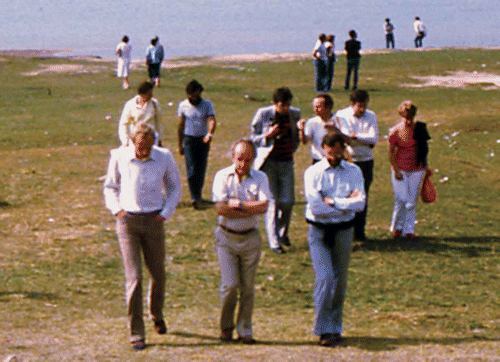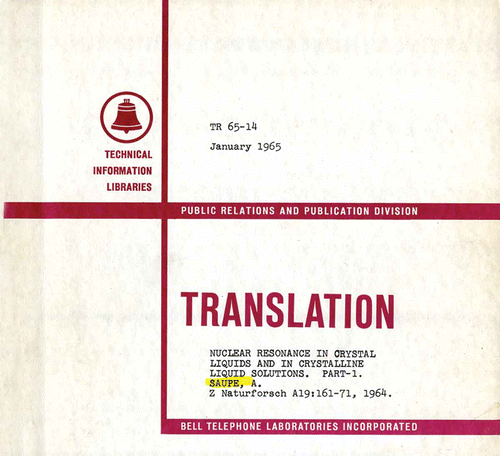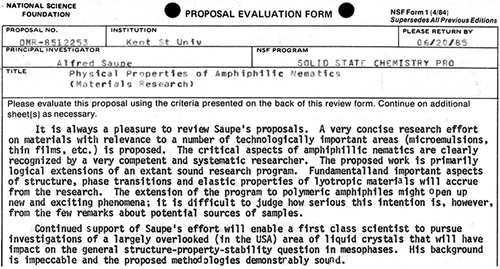1. Lost and found in translation
In the 1960s, graduate education in physics and chemistry in the United States required one to have ‘reading proficiency’ in two foreign languages from countries that had a significant scientific literature. I opted for French and German, learning just enough to answer a few general questions about a modest excerpt from the respective chemical journals. While I passed the exams, I was unable to read easily those languages and extract subtle information, especially a quantitative appreciation of complex/delicate scientific issues. And as my dissertation research involved NMR studies of lyotropic polypeptide liquid crystals, mastery of the contents of Al Saupe's papers was essential. Fortunately at that time, liquid crystals were being studied intensively at Bell Laboratories in Murray Hill, New Jersey, by Saul Meiboom and Larry Snyder. The proximity of Bell Labs to Princeton enabled me to visit periodically. On one such visit I was very happy to get a copy of an official Bell Laboratory English translation of the then newly published Saupe paper [Citation1]. At the time, these translations were perhaps my most treasured scientific possessions. I still have them (see ). Note the translator's unfamiliarity with liquid crystals: ‘kristallinen Flüssigkeiten’ was translated as ‘crystal liquids.’ In fact, none of my contemporaries in graduate school had ever heard of liquid crystals. The future ubiquitous presence of liquid crystal displays was unimaginable in 1965.
2. Broken symmetry
Over the intervening years I would meet Al on occasional visits to Kent State University and at liquid crystal meetings around the world. One such meeting is particularly memorable. It was a meeting on lyotropics organised by the Università della Calabria, in Cetraro on the coast just north of Paola, Italy, September 13–18, 1982 (see ). The proceedings of the meeting were published in Il Nouvo Cimento in 1984. Al's talk, ‘On the Structure and the Physical Properties of Micellar Nematics’ [Citation2], described the first experimental evidence for a (re-entrant) biaxial nematic phase, a lyotropic phase composed of potassium laurate/1-decanol/water, that he and Yu announced a year earlier in Physical Review Letters [Citation3].
Figure 2. Al Saupe (centre) discussing science with Heino Finkelmann (left) and Hans Gruler (right) in Calabria (September 1982).

The meeting was most memorable for me for the social aspects that involved Al. In particular, there was an obligatory meeting with the Mayor of the village of Rende, where he offered toasts to the attendees. During his speech, there was a spontaneous realisation that someone should respond to the Mayor in kind, with gratitude to the village for hosting the meeting. Several started whispering during the Mayor's speech in an effort to identify the spokesperson. Eventually, someone whispered loudly, ‘It should be the oldest of the attendees!’ At that point, the symmetry of our group was broken as everyone turned simultaneously and looked at Al! I recall being embarrassed for him, but he smoothly accepted the non-verbal nomination, and in a few milliseconds managed to come up with something uncharacteristically flowery to respond in kind to the Mayor's toast.
3. Biaxial discothéque
Later that evening, the Italian students had prepared a less formal reception – a dance party with inimitable Italian disco music playing. They really wanted this to be a fun evening, one in which everyone would ‘cut loose’, but for the most part, the scientist ‘nerds’ from abroad stood around talking shop. However, gradually people began tentatively moving to the music, and because there were more men than women, people started dancing in small groups. As I recall, Al and I were standing on the edge of the dance floor engaged in a conversation about mesogen internal degrees of freedom. I looked around and noticed that everyone but us was making an effort to oblige the Italian hosts by dancing.
Now, Al was not the kind of person you'd pick to have a good time with. Nonetheless, I summoned up enough nerve to ask Al if he would like to dance. I think it also required a fair amount of courage on his part to answer, because he, in his characteristic manner, studied me intently for several seconds before finally agreeing. And so we joined the gyrating masses. Fortunately, there are no video recordings of this event.
4. Modest proposals
Years later I would occasionally be asked to review Al's proposals for research funding (see ). Like his dancing, they were no-nonsense, rigorous, science-only research plans. I would often conclude my reviews by facetiously complaining that Al's proposal should be penalised for its conspicuous absence of hype!
References
- Saupe , A. 1964 . Z. Naturforsch , 19a : 161
- Saupe , A. 1984 . Nuovo Cimento , 3D : 16 – 29 .
- Yu , L.J. and Saupe , A. 1981 . Phys. Rev. Lett. , 45 : 1000

